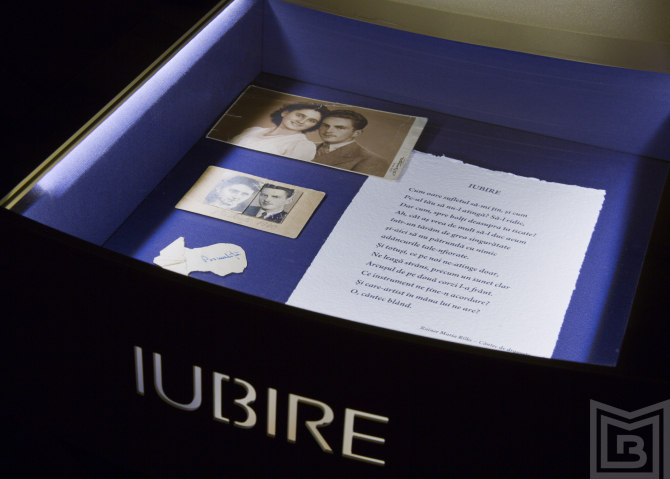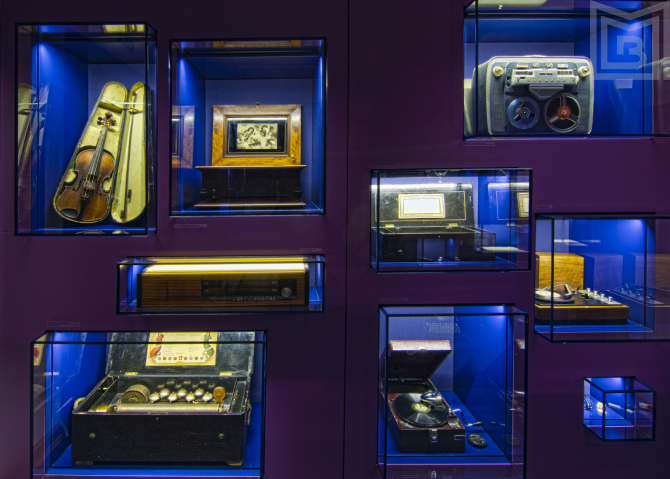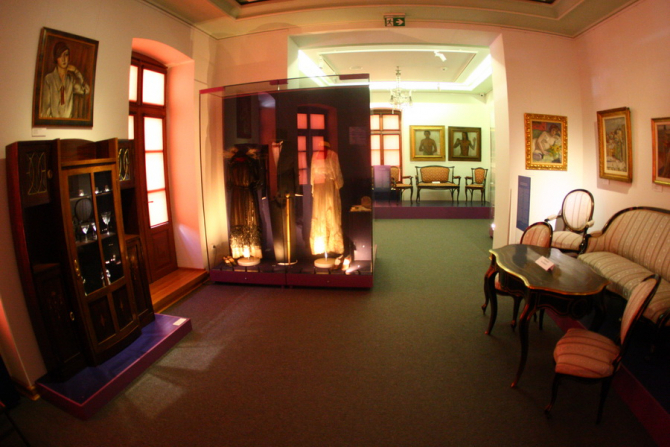
As there are already many museums in the Victoriei Square: the Grigore Antipa National Museum of Natural History, the Museum of the Romanian Peasant, the National Museum of Geology and a little bit farther, the Village Museum, one had to come up with an element of uniqueness for making a new museum. Thus, the profile of urban anthropology was chosen, which, from a museum point of view, does not yet have a correspondent in Europe, but only in America. In order to realize it, the patrimony of Bucharest was used, and the museum was meant to illustrate the lives of the people living there.
How has technology influenced our life style in the private area?
Dr. Adrian Majuru
"During a lifetime, we reach a series of thresholds, biologically once every ten years, and in an unwritten and seemingly ordinary form we have the age of the childhood we live, including adolescence here. Then, we get into maturity, we get married, we have children, we become parents, strong adults with a developing career, then we move on a step closer to senescence, our children grow, they become adults, we become grandparents. Therefore, something is changing with us. This story is not only told with the help of objects, because I wanted to prove that one of the niche elements, present in this project, is that the profession influences the way we look and we develop our behavior including metabolism, meal times, when we come home. . That's why I chose 9 characters. Some are contemporary with us and exist (in the museum) in the form of rotating cubes. On the front side we have a photo with the way they looked in adolescence, youth, and on the reverse, the old age. The differences are not given by a historical epoch or by the society in which the individual grew up and was modeled (this is the same city, after all). There are differences from one face to another, depending on the profession ”.
A priest will look in a certain way when old, in another will will look a military, in another way will an artist look or a university professor
This aspect has a dynamic that has begun to win the public over. There are also elements of physical anthropology which can help us see, by comparative method, the people who lived here for a longer period of time (500 years); as a practical study we have the necropolis in the University Square, studied by our anthropologists and anthropologists from the Francisc Rainer Institute. X-ray from both women and men skeletons which were found here provide us with comparative graphs on height, weight, on the dimensions of the large bones of the foot and hand, but also information on how the people died. We also find information about the age at which one usually ceased his or her existence in those times, and what is the standard of living and life expectancy today in Bucharest. ”
The advent of technology meant a continuous investment in refining the comfort at home

The years of communism have not only brought bad things, they also had a positive factor, to eradicate a terrible poverty DC News Archive
The positive factor which pushed us ahead at an accelerated pace over the last 200 years was technology, supported by a continuous investment in refining the comfort of our home. In the last century technology found its way into the houses of the middle class. The workforce, once specialized, began to earn a little better than the unskilled. In the end, the years of communism didn’t bring only bad things but they also had a positive factor, of eradicating a terrible poverty in the outskirts of the city, of qualifying, even if sometimes in a forced, steep manner, the young people who wanted something else and grew up to be turners or railway workers.
From the Neolithic piggy bank to the bank card
There is also a number of micro-narratives in the museum dedicated to this subject. One of these is the following: how did money influence our behaviour; we’ve noticed that the biggest investment was not in money and in a higher salary but in securing it. Along with the banknotes and coins belonging to each historical period until current times, we have also exposed the securitization containers. We couldn't expose a bank, but we did expose a bank card. We have everything from the "Neolithic piggy bank" to what we are using today to secure the currency, which we do not see anymore. We’ve changed our behavior. We spend easier, everything is easier, we like it, we adjudicate the things that appear and we adapt.
The creeping of the intellectual activities into the night and the entertainment industry
Another story found in the exhibition is about what it meant for the intellectual activities and of various trades, such as watchmakers, jewelers to slowly move into the night. It was a constant investment to try to recover as much time as possible at night, and we exposed the variety of objects to show this. From the Greco-Roman oil lamp, which you had to frequently feed, to the candle of pre-industrial times made from a thick seam that held for 3-4 hours, further, to the gas lamp and even the led you attach on your ear and read a book. All these have brought changes in metabolism, changes in the hours when we had our meals. The entertainment industry appears with the electric light bulb. (It existed before as the Venetian Carnival was celebrated in the Middle Ages, with lanterns. Not everyone could afford this activity, however. To close a city and live there. Not everyone was enjoying it.) After 1850, the use of air and lamp gas appeared on the streets. When was there time for the entertainment industry to develop as people were working during the day? In recent times new professions related to the entertainment industry or service industry of all kinds slowly moved into the night. Also people who have no choice but shift their work inot the night, as having a real time conversation with someone from the other meridian requires making an effort. All of these exist in the exhibition.
From investments in communication to the disappearance of flirting

After the First World War, investments also start in services concerning real-time communication Photo: Bucharest Municipal Museum
Another story is about the extent to which the distances which have now been shortened by technology have brought us closer or have alienated us, from a human point of view. Time and patience while waiting for a girl were perceived differently, writing a letter, tearing the paper apart because you could not find the right words (also the girls were more attentive at the message.) Then the telegraph and the telephone appeared in public institutions and in the homes of people with money. The phone was not affordable for everyone, the same was with the car. After the First World War, investments in real-time communication services began. It was through military circuit in World War II that telephony became more accessible. This was a test that eventually proved to be positive for shortening the distances. From the classical letter to the internet and the message on WhatsApp the language changes, everything happens very fast and privacy can be diminished. A state of mind is created which lacks creativity and fantasy in a relationship. Even the flirting is gone, if people sit and drink a beer together, but they are on the phone and communicate through messages, without looking into eachother’s eyes. These things did not exist in the last 30 years. This thing can also be solved through technology.
The Museum of Ages is an exhibition that you have to come back to in order to better understand what is going on with you
There are 5-7 minutes spots which show you in explained images, like a movie, what life at home and at school was like, the pedagogy that formed one (in the family), how it was to go on the street (on a historical scale) and what the city was offering you. Then the way the human face evolved in the urban environment and what happened to it as the years went by.
Neagu Giuvara tells us in an interview how his generation thinks of the present-day Romania compared to his generation’s youth, 60-70 years ago. This film is antithetical to another one of about 7 minutes which reveals our evolution over a longer span of time, using images and narratives. This means looking at two-three generations and at the impact technology had, with the changes it brought, the social stratifications and professions.
A book called "The History of Urban Physiognomy, from Childhood to Senescence (1800 - 2000)" published two years ago, contains images from the patrimony of the Municipal Museum of Bucharest and the National Art Museum of Romania: paintings, engravings, photographs, explaining changes in the unspoken language: attitudes, looks, clothing, lack of smile, people blossoming or decaying, and what actually lies behind these photos.
Visitors do not know what to expect
Visitors usually have a surprise. They do not know what to expect when they come to the Museum of Ages, because it represents an element of novelty. In the first museum hall, there are several introductory zones that send us to different exhibiting spaces. One can go in parallel and choose an exhibiting unit of technology, then another, of a narrative dedicated to the space at home. There are also museum spaces arranged in a classical style, with interior reconstructions, specific for some historical periods. There are spaces for those who are interested in how we evolved, of physical anthropology, where for the first time, we exhibit osteological pieces dedicated to some eradicated diseases, which were once very present in this city: tuberculosis and syphilis. These osteological pieces bear the imprint of these diseases. Cultural anthropology is therefore used in here.
Visitors have a surprise. I don't know what to expect when I come to Vârstelo Museum DC News Archive
Our gene, studied by Francisc Rainer even in isolated villages, proved an uninterrupted inhabitance, after looking at the DNA data of the ancient necropolis he researched. We carry ancient seeds of migrations from the end of the Stone Age and from the beginning of the Neolithic, of populations that came from the area of today’s Russia and from the Altai Mountains, and which gradually populated, in waves (as the Slavs did in the Middle Ages ) Eastern and Central Europe, mixing with ancient populations. We are the same as our predecessors of 3, 4, 5 generations ago. There are differences in weight and height, depending on the social environment in which one lived. Malnutrition is another factor, so is living in a balanced family and society. Food being nutritious, childhood diseases being eradicated are other factors.
The change of the physiognomy depending on where you work
Why does the physiognomy change according to the workplace?
There are things that can happen in a lifetime or over several generations. There are external pressures that over time shape a person, such as: personal safety, emotional safety, then the fact that you can feed yourself, you can prepare yourself for a profession and choose what you like. All these, over time, become pressure factors that shape us. Some of the individuals are stout, they resist and they pursue their dream and achieve what they want. This is easier now than one or two generations ago. For example, today, girls no longer have to get married when they were 19-20. On a larger time scale, this is about a balance that must be maintained in a society for at least 100 years (at least.) That is why the people from the interbelic period looked biologically different than us, if we are to consider the height.
Prohibitions, emotional, professional and social stress over a very long period of time break these very sensitive connections. For example, if you give a person whose level is below the middle class a lot of money and move him to a palace, he will lower that palace to his level, he will not raise it. If you take an aristocrat who lived in the Stirbei Palace, as was the case of Princess Nadeja, and you move her to a block in the neighborhood, you will notice that the apartment will look differently (in a good sense.)
In order to evolve you have to do it in stages. Education, study, profession, play an essential role. "
About Filipescu-Cesianu House
The building where the exhibition of the Museum of Ages is presented existed in an previous version, only with a corner. "The Filipescu-Cesianu House is one of the few aristocratic residences from the Bucharest of the Belle Époque, remaining faithful to its initial design”, we find on the MMB website.
It belonged to the Filipescu family (Iancu and Maria Ghica), during the time of Alexandru Ioan Cuza. The Cesianu family (Constantin Cesianu) buys it at the end of the 19th century, after 1880, and erects the current version of the front body , in imperial style. Then another building part is designed, as well as the alleyways of the park. Subsequently, at the end of the interbelic period, the Cesianu family sells the property to the Romanian Radio Society, for the latter to setup its new headquarters. Later, the Radio Society exchanged the Filipescu Cesianu House with the Municipality for another property on which the Radio Hall was eventually built.
The Bucharest City Hall rehabilitated the building in order to integrate it into the tourist circuit. And, as far as one can see, this has been successfully done. The organizers would like more and more people from Bucharest, and from the rest of the country and abroad to find out about this special place and to come and relax and find answers. We were enthousiastically informed by our host that parents are welcome with their children. There are many interesting things to learn.
I left towards a new destination smiling, after having waved to a grandfather in the park of the museum. Why not smile to him and to everyone who finds something beautiful in every age?
(Photos by courtesy of the Municipal Museum of Bucharest)




